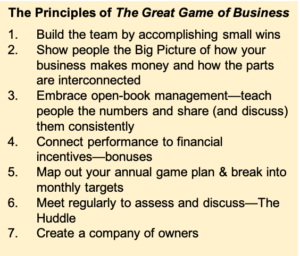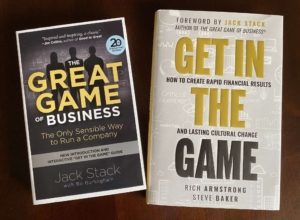Engaging employees as owners:
Black Wolf Design embraces open-book management
How do you make sure your employees are engaged and motivated to help your company succeed? Bring them close, show them the numbers, and make the connection for how their actions affect results. Then give them a stake in the returns.
Here at Black Wolf Design we wanted to create a culture in which every person in our company, regardless of their job title, has an understanding of the business and clear accountability for their impact on our results. To that end, we initiated open-book management this year, leveraging some of the ideas in the book The Great Game of Business by Jack Stack and its follow-up, Get in the Game by Rich Armstrong and Steve Baker.
At its “end,” we will have a company of owners who understand the financials of the business and how their actions and choices affect the outcome.
Kicking it off: the Huddle
Our approach started with the introduction of the “Huddle,” a weekly all-staff meeting to participate in forecasting our progress against monthly targets. We have an annual forecast broken into monthly targets. For each month we have a scoreboard listing the line items of our income statement and showing the forecast for the month, as well as YTD forecast and YTD actuals. Each employee has responsibility for at least one line item on the income statement. They review weekly activity in their account(s) in preparation for the meetings.
In the Huddle, we proceed through the income statement, line by line, starting with sales. Each team member projects where we will be at month’s end with their particular line item and tells a story of how and why we will get there. If we are ahead of the plan number: shouts, clapping, and a little laughter. If we are falling behind, we discuss what is influencing the number and ways to address it before month’s end.
The objective is to give each and every employee the knowledge of what is involved with operating the business. Most staff report on line items related to their work on the floor. This gives them a direct line of sight to how the work they are doing is influencing the financials of the company.
We saw immediate changes…
The impact has been significant and instantaneous. With one team member, we discussed hiring an additional full-time employee to help in their cell as it had become a constraint for us. He was pleased to hear this but was also concerned with the additional cost of that FTE and how that would affect our forecasting for the remainder of the year. We discussed the impact and what we’d need to do to offset the additional costs and moved forward with the hire.
Through this type of conversation, along with similar conversations we have in the huddle, we begin to teach financial literacy to every member of the organization. This is a key part of open-book management, the process of teaching financial literacy as we build a culture of ownership within the organization.
…and the impact is already evident in the numbers
Results have been significant in the short period of time we’ve been practicing it. Our gross margins are up significantly, and our expectations are that our bottom line will exceed our forecast by an additional 5%!
Mini-Games—solving specific problems as a team
Within the “Game” there are also Mini-Games. Defined by the Great Game Of Business, A MiniGame™ is an engaging, short-term activity designed to pursue an opportunity or correct a weakness within a company. MiniGames have a theme and are meant to be fun and engaging. Like other games, they should have a goal, a defined time frame, a scoreboard, and a prize.
We recently started our first mini-game focused on keeping our assembly team at their benches doing assembly work. Often, these staff members are taken away from their benches helping others reassemble after finishing or moving upstream into the rough mill or sub-assembly areas to assist, or just being interrupted by others with various and many questions. The goal is to improve throughput in an area that is the drumbeat of our topline sales as well as change the behaviors of most all that are on the floor and even in the office. The assemblers are conscious of focusing on their work in assembly. Others are conscious of the work that needs to be done by them and the remaining team members to keep assemblers where they are. Stay tuned as we are in the first week of a 12-week game.
By the way, the theme for this game is “Putting the Hops in Assembly.” Being in Wisconsin, who doesn’t like beer? Especially craft beer these days! The scoreboard is a piece of plywood cut into the shape of a keg and the hours tracked are recorded with stickers of mugs of beer. Prizes are tied to the beer theme as well with gift cards to local breweries, coozies, and even some Black Wolf wearables thrown in! Everybody was involved in the process and engaged.
The success behind the story
The foundations of “The Great Game” were created when a manufacturing division was about to be closed by its parent company, and the employees—ordinary people without business experience—took control, learning as they went and creating new ways of managing the business in order to save their jobs and their company. They succeeded, and now the principles of The Great Game have been spread over the past 20+ years through several books and a coaching organization established by the creators.

Learn more & try it yourself
Want to learn more about The Great Game and how it can help your business? Contact me to talk, and check out the books for full details. (There are audiobook versions for those who like to multitask while reading.)

